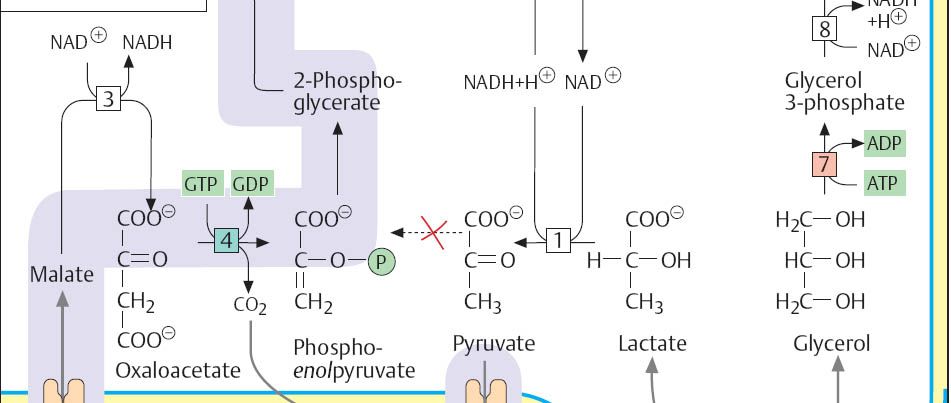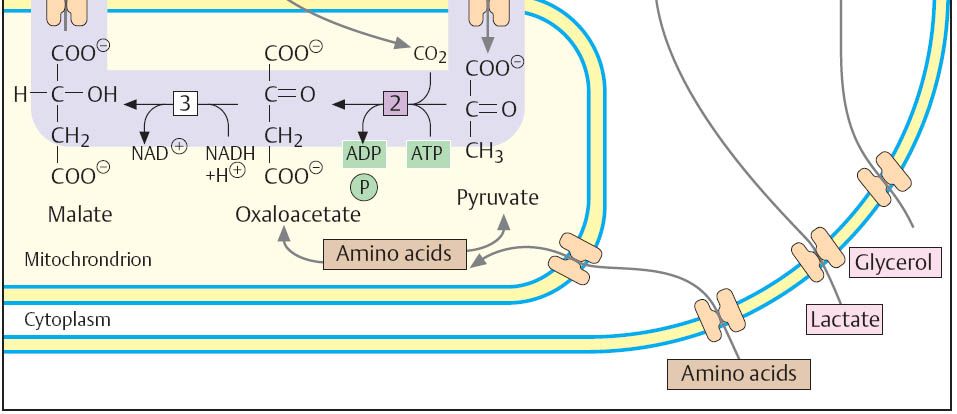A.Gluconeogenesis
Many of the reaction steps involved in gluconeogenesis
are catalyzed by the same enzymes that are used in glycolysis. Other enzymes
are specific to gluconeogenesis and are only synthesized, under the influence
of cortisol and glucagon when needed. Glycolysis takes place exclusively when
needed in the cytoplasm, but gluconeogenesis also involves the mitochondria and the endoplasmic reticulum. Gluconeogenesis
consumes 4 ATP(3 ATP + 1 GTP) per glucose – i.e. , twice as many as glycolysis
produces.
1)
Lactate is a precursor for gluconeogenesis is mainly derived from muscle and
erythrocytes. LDH oxidizes lactate to pyruvate, with NADH+H+
formation.
2)
The first
steps of actual gluconeogenesis take place in the mitochondria. The reason for this detour is the equilibrium state
of pyruvate kinase reaction. Even coupling to ATP hydrolysis would not be
sufficient to convert pyruvate directly
into phosphenol pyruvate(PEP). Pyruvate
derived from lactate or amino acids is therefore initially transported into the
mitochondrial matrix, and-in a biotin-dependent reaction catalyzed by pyruvate carboxylase – is carboxylated
there to oxaloacetate. Oxaloacetate
is also an intermediate in the tricarboxylic acid cycle. Amino acids with break down products that enter the cycle or supply
pyruvate can therefore be converted into glucose.
3)
The
oxaloacetate formed in the mitochondrial matrix is initially reduced to malate, which can leave mitochondria
via inner membrane transport systems.
4)
In the
cytoplasm, oxaloacetate is reformed and then converted into phosphoenol pyruvate by a GTP-dependent
PEP carboxykinase. The subsequent
steps up to fructose 1,6-biphosphate represent the reverse of the corresponding
actions involved in glycolysis. One additional ATP per C3 fragment is used for
synthesis of 1,3 biphosphoglycerate. Two gluconeogenesis-specific phosphatases
then successively cleave off the phosphate residues from fructose 1,6-biphosphate. In between these reactions lies the
isomerization of fructose 6-phosphate to glucose
6-phosphate – another glycolitic reaction.
5)
The
reaction catalized by fructose-1,6
biphosphatase is an important regulation point in gluconeogenesis.
6)
The last
enzyme in the pathway, glucose
6-phosphatase, occurs in the liver, but not in muscle. It is located in the
interior of the smooth endoplasmic reticulum. Specific transporters allow
glucose 6-phosphate to enter the ER and allow the glucose formed there to run to the cytoplasm. From there, it is
ultimately released into the blood.
“Coloured atlas of biochemistry”, second edition; J. Koolman, K.H. Roehm












0 коментара:
Постави коментар